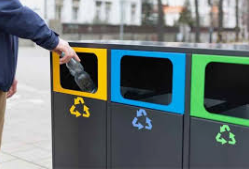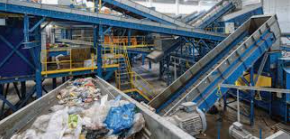Sorting of commercial waste and bulky waste
Sorting of Commercial Waste and Bulky Waste: A Vital Step Towards Sustainable Waste Management
Waste management is a critical aspect of environmental sustainability, and effective sorting of commercial and bulky
waste plays a pivotal role in this process. With urbanization and industrialization on the rise globally, the volume of
waste generated continues to grow. Addressing this challenge requires efficient systems for waste collection, sorting,
recycling, and disposal. In this article, we delve into the significance of sorting commercial and bulky waste, exploring
its benefits, challenges, and best practices.
![HKK4[0E(0PS@H]8XKSI1ROL.png](/uploads/allimg/20240618/1-24061Q63041527.png)
Importance of Sorting Waste
Sorting waste at its source, whether in commercial establishments or residential areas, is fundamental to maximizing
resource recovery and minimizing environmental impact. Commercial waste includes waste generated by businesses,
offices, institutions, and industries. Bulky waste encompasses large items such as furniture, appliances, and construction
debris. Proper sorting of these waste streams allows for:
Resource Recovery: Many materials in commercial and bulky waste can be recycled or reused. Sorting enables the
identification and separation of recyclable materials like paper, cardboard, plastics, and metals, diverting them from
landfills.

Waste Reduction: Effective sorting reduces the amount of waste sent to landfills or incineration facilities, thereby
conserving landfill space and reducing greenhouse gas emissions associated with waste disposal.
![JXKL9S]JY6V~FJG~(9Y}IDQ.png](/uploads/allimg/20240618/1-24061Q63Ua55.png)
Cost Savings: Recycling and reusing materials can be more cost-effective than disposing of them. Businesses can
potentially save on waste disposal fees and may even generate revenue from selling recyclable materials.
Environmental Protection: By reducing landfill waste and promoting recycling, sorting helps conserve natural
resources, reduce
energy consumption, and mitigate pollution associated with waste disposal.
Challenges in Sorting Waste
While sorting waste offers significant benefits, several challenges need to be addressed to optimize the process:
Complexity of Waste Streams: Commercial and bulky waste can be diverse and complex, containing various
materials that require different handling and processing techniques.

Logistical Issues: Collection and transportation of bulky items can be challenging due to their size and weight,
necessitating specialized equipment and logistical planning.
Awareness and Compliance: Ensuring that businesses and individuals are aware of sorting requirements and
comply with waste management regulations is crucial but often requires education and enforcement measures.
Costs and Infrastructure: Setting up and maintaining waste sorting facilities, recycling centers, and collection
systems entail costs that may deter investment without adequate financial incentives or regulatory support.
Best Practices in Waste Sorting
To overcome these challenges and maximize the benefits of waste sorting, several best practices can be implemented:
Education and Outreach: Providing businesses and communities with information on proper waste sorting practices,
recycling guidelines, and the benefits of waste reduction fosters awareness and encourages participation.
Integrated Collection Systems: Implementing efficient collection systems that cater to different types of waste streams,
including bulky items, ensures timely and effective waste removal.
Technology and Innovation: Utilizing technology such as sensors for waste monitoring, automated sorting systems,
and advanced recycling technologies enhances efficiency and accuracy in sorting processes.
Collaboration and Partnerships: Engaging stakeholders including businesses, municipalities, waste management
companies, and recycling facilities fosters collaboration and strengthens the waste management infrastructure.
Policy Support: Governments can play a crucial role by implementing policies that incentivize waste reduction,
promote recycling, and enforce waste sorting regulations.
Conclusion
Sorting commercial and bulky waste is not just a regulatory requirement but a cornerstone of sustainable waste
management practices. By implementing effective waste sorting strategies, businesses and communities can reduce
their environmental footprint, conserve resources, and contribute to a circular economy where waste is minimized and
material are reused or recycled.Continued innovation, education, and collabortion are essential to overcoming challenges
and achieving long-term sustainabilitygoals in waste management. As individuals and organizations embrace the
importance of waste sorting, we move closer to acleaner, healthier planet for future generations.
![DSP@0V5UE59A_U$~YB2)]EF.png](/uploads/allimg/20240618/1-24061Q64505464.png)
In conclusion, sorting commercial and bulky waste is not merely a procedural step but a proactive measure that
empowers us to make meaningful strides towards environmental stewardship and sustainable development.
-
 Trommel screenTrommel screen, also known as drum screens, are widely used in various industries for sorting and separating materials.Get Quote
Trommel screenTrommel screen, also known as drum screens, are widely used in various industries for sorting and separating materials.Get Quote -
 Crop straw double shaft shreddApplications:Biomass Energy Production: Shredded straw can be used as a feedstock for bioenergy plants to produce electricity or heat.Livestock Feed: Reduced-si...Get Quote
Crop straw double shaft shreddApplications:Biomass Energy Production: Shredded straw can be used as a feedstock for bioenergy plants to produce electricity or heat.Livestock Feed: Reduced-si...Get Quote -
 Zhongcheng Air Drum SeparatorAir drum separators effectively separate lightweight materials (e.g., plastics, paper) from heavier materials (e.g., metals, glass). This high efficiency is cru...Get Quote
Zhongcheng Air Drum SeparatorAir drum separators effectively separate lightweight materials (e.g., plastics, paper) from heavier materials (e.g., metals, glass). This high efficiency is cru...Get Quote
-
2024-08-07Efficient Material Separation with Bounce ScreensThe ballistic separator is an important equipment with separation function designed for the sorting of inorganic particles in the coarsely crushed waste.
-
2023-01-12WindshifterWindshifter (Air Drum Separator ) is the ideal solution for separating all kind of waste types into two fractions, heavy and light. The robust construction and ...
-
2023-01-11Ballistic SeparatorBallistic separators are a crucial component in modern recycling and waste management systems, contributing to more efficient resource recovery and environmenta...
-
2024-05-18Mobile Jaw Crusher PlantMobile jaw crushing station is a novel rock crushing equipment, also known as mobile crushing station. The purpose of its design concept is to stand from the cu...
-
2024-07-09Recycling Balers-Safe,Easy-To-Use and affordableThe operating principle of a strapping machine primarily involves the following steps:1.Item Positioning:Firstly, the item to be strapped must be placed accurat...



